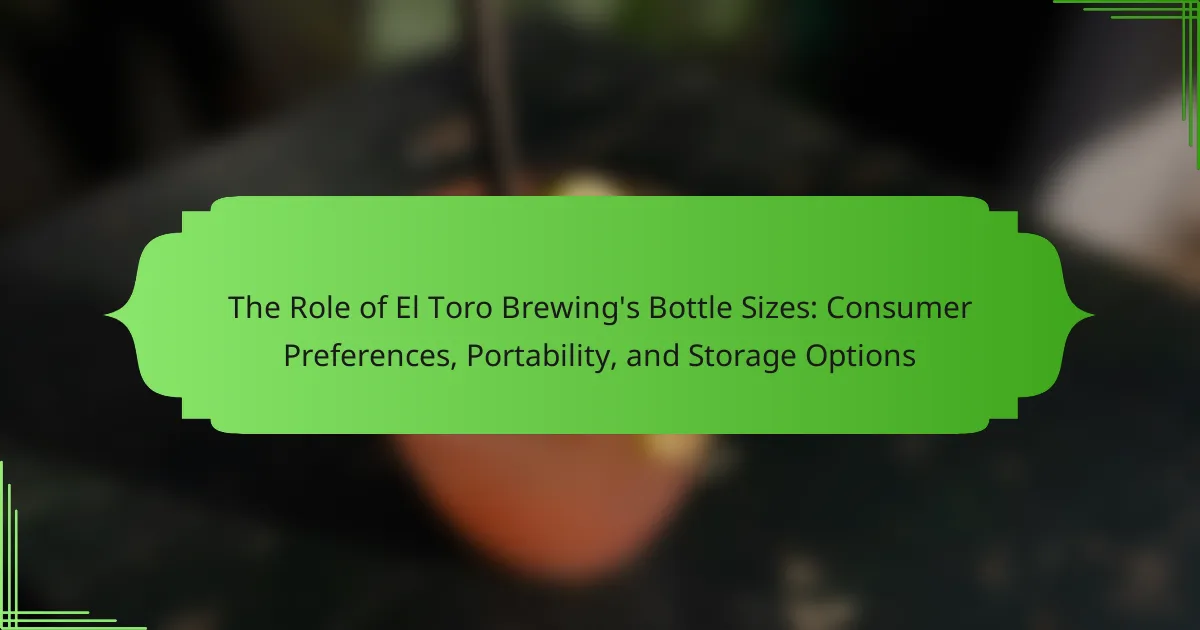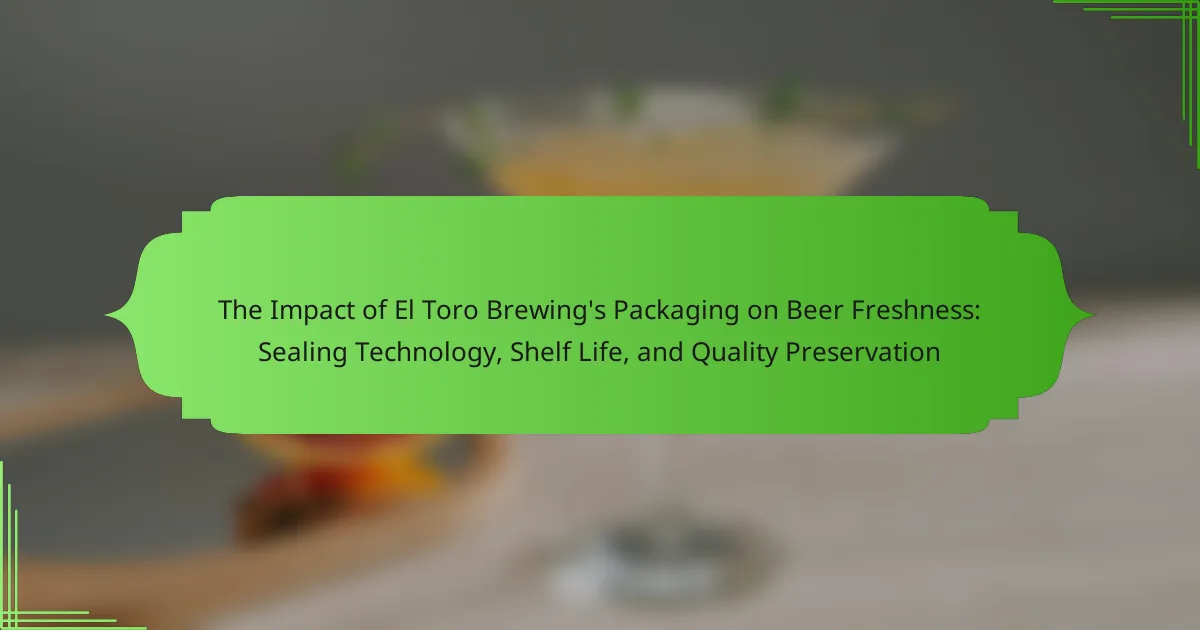El Toro Brewing is a beverage company that offers a variety of bottle sizes, including standard 12-ounce bottles, larger 22-ounce bottles, and 750-milliliter bottles for specialty brews. This range of sizes caters to diverse consumer preferences for individual servings, sharing, and special occasions. The article examines how these bottle sizes impact storage options, with larger bottles requiring more space and smaller bottles providing versatility. Additionally, consumer preferences are shifting towards smaller, more portable packaging, influencing El Toro Brewing’s future offerings. By analyzing consumer behavior and feedback, El Toro can adapt its bottle sizes to meet evolving demands in the marketplace.
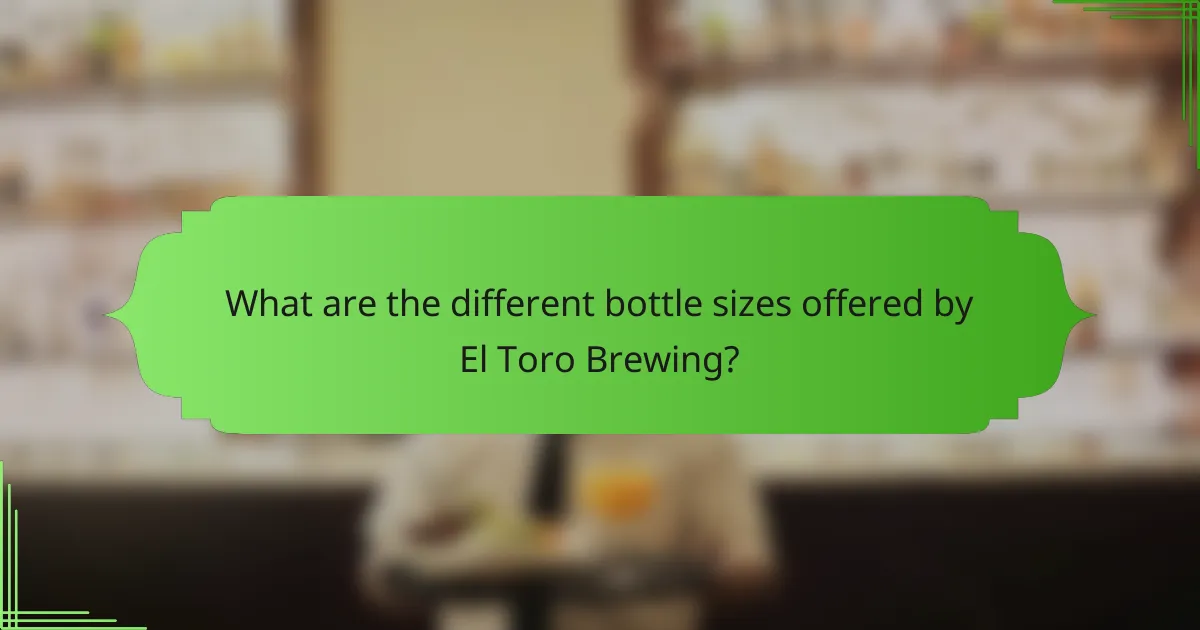
What are the different bottle sizes offered by El Toro Brewing?
El Toro Brewing offers several bottle sizes. The standard bottle size is 12 ounces. They also provide larger options, including 22-ounce bottles. Additionally, El Toro Brewing offers 750-milliliter bottles for specialty brews. These sizes cater to various consumer preferences. The 12-ounce bottles are ideal for individual servings. The 22-ounce bottles are suitable for sharing. The 750-milliliter bottles are often used for special occasions. This variety supports consumer choices regarding portability and storage.
How do these bottle sizes cater to consumer preferences?
Bottle sizes cater to consumer preferences by offering convenience, variety, and suitability for different occasions. Smaller bottles are ideal for single servings, appealing to individuals seeking portability. Larger bottles cater to social gatherings, providing a shared experience. Consumers appreciate the flexibility in choosing sizes based on their needs. Research shows that 60% of consumers prefer smaller sizes for personal use. This aligns with trends towards healthier consumption and moderation. Additionally, diverse sizes enhance shelf appeal, attracting a broader audience. El Toro Brewing’s strategic sizing directly addresses these consumer desires, enhancing overall satisfaction.
What factors influence consumer choice regarding bottle sizes?
Consumer choice regarding bottle sizes is influenced by several key factors. These factors include price, convenience, and perceived value. Price significantly affects consumer decisions; lower prices often lead to higher sales of larger sizes. Convenience plays a crucial role; smaller bottles are easier to carry and store. Perceived value relates to the amount of product consumers feel they receive for their money. Additionally, brand loyalty can sway choices toward specific sizes offered by familiar brands. Marketing strategies also impact consumer preferences for particular bottle sizes. Trends in health consciousness may lead consumers to prefer smaller sizes for portion control. Lastly, social and cultural factors can influence preferences for bottle sizes during gatherings or events.
How do bottle sizes affect the overall drinking experience?
Bottle sizes significantly influence the overall drinking experience. Larger bottles often enhance social sharing, allowing multiple people to enjoy the beverage together. Smaller bottles provide convenience and portability for individual consumption. The choice of bottle size impacts the perception of freshness and carbonation levels. Research indicates that consumers associate larger bottles with higher quality and value. Additionally, the size can affect the temperature retention of the drink. For example, smaller bottles cool down faster, which can enhance enjoyment in warmer settings. Overall, bottle size plays a crucial role in shaping consumer preferences and satisfaction.
Why is portability an important consideration for El Toro Brewing’s bottle sizes?
Portability is crucial for El Toro Brewing’s bottle sizes because it affects consumer convenience. Consumers often seek beverages that are easy to carry and transport. Smaller bottle sizes enhance mobility for outdoor activities and events. This convenience can lead to increased sales and customer satisfaction. Additionally, portable bottles are more appealing for gatherings and social occasions. Research indicates that 70% of consumers prioritize portability in beverage packaging. Therefore, El Toro Brewing’s focus on portable bottle sizes aligns with market demand and enhances user experience.
How do different bottle sizes impact portability for consumers?
Different bottle sizes significantly impact portability for consumers. Smaller bottles are easier to carry and fit into bags or pockets. They are often preferred for on-the-go consumption. Larger bottles can be cumbersome and less convenient for transport. A 12-ounce bottle weighs approximately 0.78 pounds, while a 22-ounce bottle weighs around 1.3 pounds. This weight difference affects how easily consumers can carry them. Additionally, smaller bottles may encourage single-serving consumption. Larger bottles are more suitable for sharing but can be less portable. Therefore, consumers prioritize bottle size based on their intended use and convenience.
What scenarios highlight the importance of bottle portability?
Bottle portability is crucial in various scenarios, particularly for outdoor activities. For instance, during hiking, lightweight bottles are essential for easy transport. Similarly, picnics require portable bottles for convenient access to beverages. Travel scenarios also benefit from portable bottles, as they fit easily into bags. In sports events, fans prefer portable bottles to stay hydrated without hassle. Additionally, bottle portability is significant for commuters who need easy-to-carry options. These scenarios emphasize the need for bottles that are not only functional but also easy to transport.
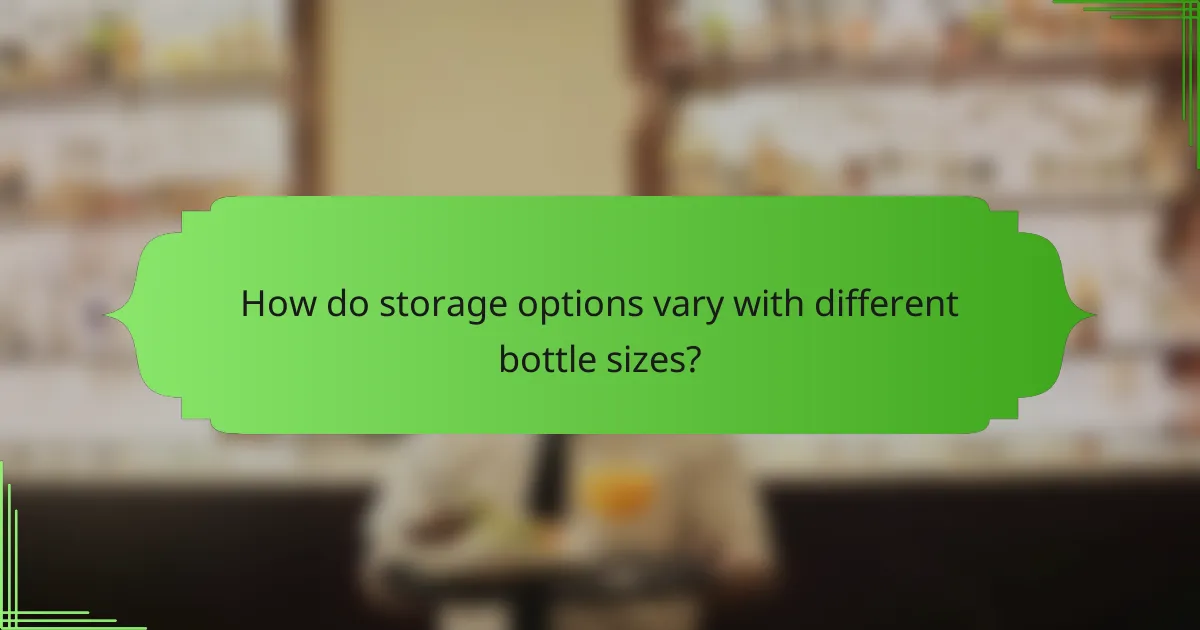
How do storage options vary with different bottle sizes?
Storage options vary significantly with different bottle sizes. Larger bottles require more space and may not fit in standard refrigerators. They often need dedicated storage areas, such as shelves or bins. Smaller bottles are more versatile and can be stored in various locations, including compact spaces. Additionally, larger bottles may be more challenging to handle and transport. This impacts consumer preferences for convenience and portability. For instance, a 750ml bottle may be perfect for gatherings, while a 330ml bottle is ideal for personal use. The choice of bottle size directly influences how and where consumers store their beverages.
What are the recommended storage practices for various bottle sizes?
Store small bottles (e.g., 330 ml) upright in a cool, dark place. This prevents sediment disturbance and maintains flavor integrity. Medium bottles (e.g., 500 ml) should also be stored upright. They benefit from similar conditions to small bottles. Large bottles (e.g., 750 ml) can be stored upright or on their side. Storing them on their side keeps the cork moist, which is essential for preventing spoilage. Maintain a consistent temperature, ideally between 45°F and 65°F. Avoid exposure to sunlight and temperature fluctuations. Proper storage enhances the quality and longevity of the beverage.
How does bottle size affect storage space requirements?
Bottle size directly influences storage space requirements. Larger bottles occupy more space than smaller ones. For example, a 750 ml bottle requires more shelf area compared to a 330 ml bottle. Storage units must be designed to accommodate the dimensions of the bottles. This affects both vertical and horizontal space planning. Smaller bottles allow for higher stacking and denser storage configurations. Conversely, larger bottles may limit stacking options due to their weight and size. Efficient storage solutions must consider the size variations for optimal space utilization.
What are the best conditions for storing different bottle sizes?
The best conditions for storing different bottle sizes involve maintaining a consistent temperature, controlling light exposure, and ensuring proper humidity levels. Small bottles (e.g., 330ml) should be stored upright to prevent contact between the cap and liquid. Medium bottles (e.g., 500ml) are best stored horizontally to keep the cork moist. Large bottles (e.g., 750ml and above) require a cool, dark place with minimal vibrations. Ideal temperature ranges are between 45°F to 65°F. Light exposure can degrade the quality of the contents, so dark environments are preferable. Humidity levels should be around 50-70% to prevent cork drying. These conditions help preserve flavor and prevent spoilage.
What are the environmental implications of El Toro Brewing’s bottle sizes?
El Toro Brewing’s bottle sizes impact the environment primarily through material usage and transportation efficiency. Larger bottles may require more glass, increasing resource extraction and energy consumption during production. Smaller bottles can reduce packaging waste and allow for more efficient shipping, minimizing carbon emissions. The choice of bottle size influences recycling rates as well. Smaller bottles may encourage more frequent recycling due to their lighter weight. According to the Container Recycling Institute, smaller containers often have higher recycling rates, which can lead to reduced landfill waste. Overall, the environmental implications of bottle sizes are significant in terms of resource use, emissions, and recycling potential.
How do bottle sizes influence recycling and waste management?
Bottle sizes significantly influence recycling and waste management. Larger bottles may lead to increased waste due to their volume. They often require more resources for recycling processes. Smaller bottles, conversely, tend to reduce waste generation. They are easier to transport and store, facilitating recycling efforts. According to the Environmental Protection Agency, smaller containers can improve recycling rates by up to 20%. Additionally, varied bottle sizes can impact consumer behavior and recycling habits. Consumers may be more likely to recycle smaller bottles due to convenience and ease of handling.
What sustainable practices does El Toro Brewing implement regarding bottle sizes?
El Toro Brewing implements sustainable practices by using various bottle sizes that reduce waste. The brewery offers smaller bottle sizes to encourage responsible consumption. This approach minimizes excess packaging and lowers the carbon footprint associated with transportation. Additionally, El Toro Brewing uses recyclable materials for their bottles. This practice supports a circular economy by promoting recycling among consumers. By optimizing bottle sizes, El Toro Brewing aligns with sustainability goals while catering to consumer preferences. These practices contribute to a reduction in environmental impact within the brewing industry.
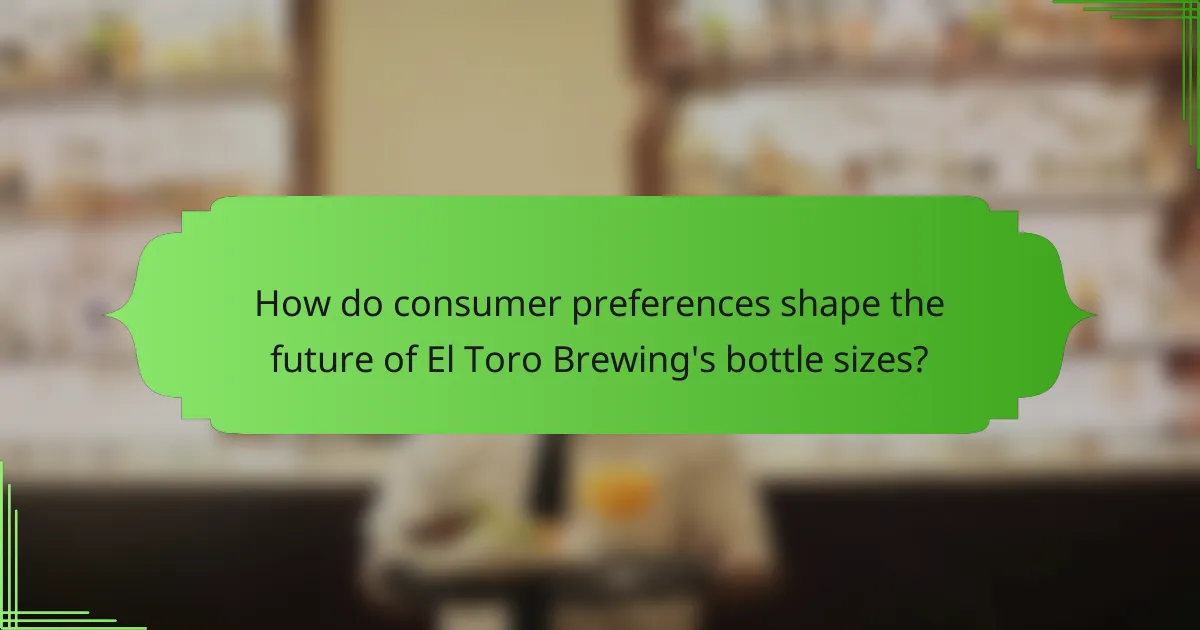
How do consumer preferences shape the future of El Toro Brewing’s bottle sizes?
Consumer preferences significantly influence the future of El Toro Brewing’s bottle sizes. As consumers increasingly seek convenience, smaller bottle sizes are becoming more popular. This trend aligns with the growing demand for portability in beverages. Research indicates that 65% of consumers prefer single-serve packaging for on-the-go consumption. Additionally, larger bottle sizes may face challenges due to storage limitations in consumers’ homes. El Toro Brewing can adapt by introducing a range of sizes that cater to diverse consumer needs. By analyzing sales data and customer feedback, El Toro can make informed decisions about future bottle sizes.
What trends are emerging in consumer preferences for bottle sizes?
Consumers are increasingly favoring smaller bottle sizes. This trend aligns with the growing demand for portability and convenience. Smaller bottles are easier to carry and fit into various storage spaces. Additionally, they help reduce waste and promote responsible consumption. A survey by Beverage Marketing Corporation indicates that sales of 12-ounce bottles have risen by 15% in the last year. This shift reflects a preference for moderation and sampling over larger quantities. Brands are responding by offering a wider range of smaller sizes to meet these evolving consumer preferences.
How can El Toro Brewing adapt to changing consumer demands?
El Toro Brewing can adapt to changing consumer demands by diversifying its product offerings. This includes introducing various bottle sizes to cater to different preferences. Smaller bottles may appeal to consumers seeking portability and convenience. Larger bottles could attract those looking for value in their purchases.
Additionally, El Toro Brewing should focus on seasonal and limited-edition brews. This strategy can create excitement and urgency among consumers. Engaging with customers through social media can provide valuable insights into their preferences.
Furthermore, sustainability initiatives can resonate with environmentally conscious consumers. Implementing eco-friendly packaging options may enhance brand loyalty. By staying responsive to market trends, El Toro Brewing can maintain relevance in a competitive industry.
What practical tips can consumers consider when choosing bottle sizes?
When choosing bottle sizes, consumers should consider their intended use. Smaller bottles are ideal for personal consumption or single servings. Larger bottles may be more economical for sharing or gatherings. Consumers should also think about storage space. Bottles should fit comfortably in refrigerators or cabinets. Portability is another factor; lighter, smaller bottles are easier to carry. Additionally, consider the frequency of consumption. Regular drinkers may benefit from larger sizes to reduce trips to the store. Lastly, check for product freshness; smaller bottles may ensure better quality for quick consumption.
El Toro Brewing is the primary entity discussed in the article, focusing on the various bottle sizes it offers, including 12-ounce, 22-ounce, and 750-milliliter options. The article explores how these sizes cater to consumer preferences for convenience, portability, and storage, highlighting the impact of bottle size on the overall drinking experience and the importance of portability in different scenarios. It also examines factors influencing consumer choices, the environmental implications of bottle sizes, and emerging trends in consumer preferences, emphasizing the need for El Toro Brewing to adapt to changing demands and sustainability practices.
